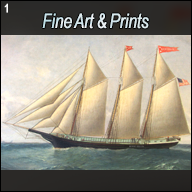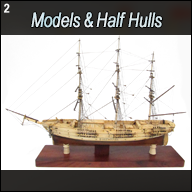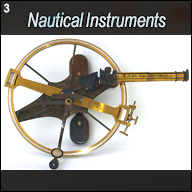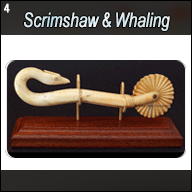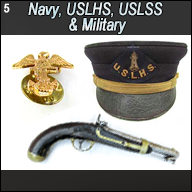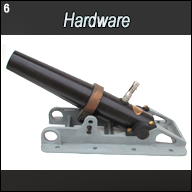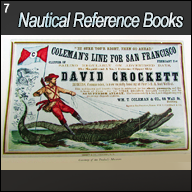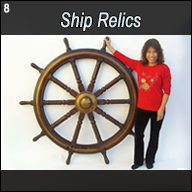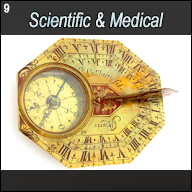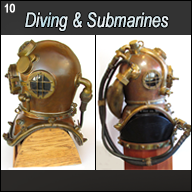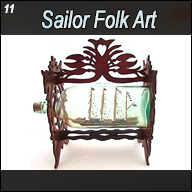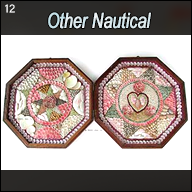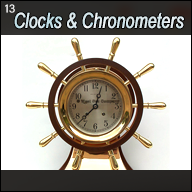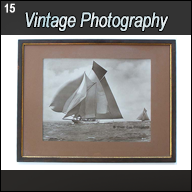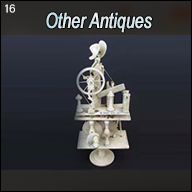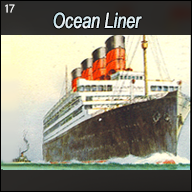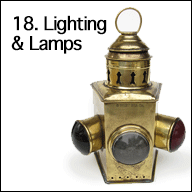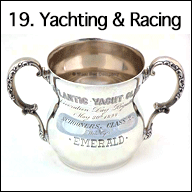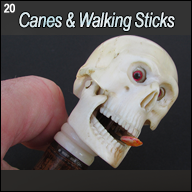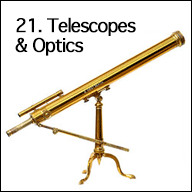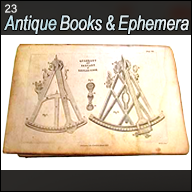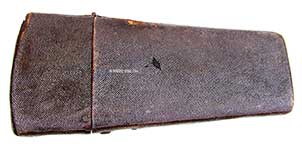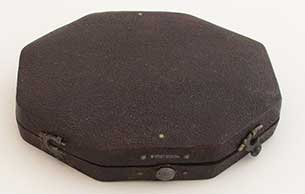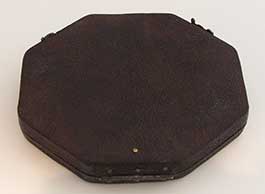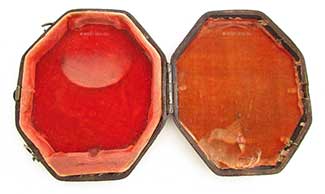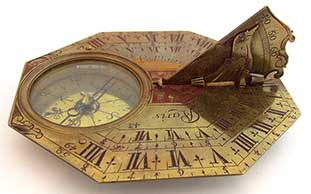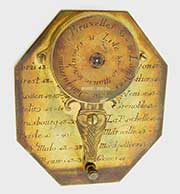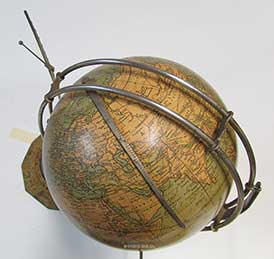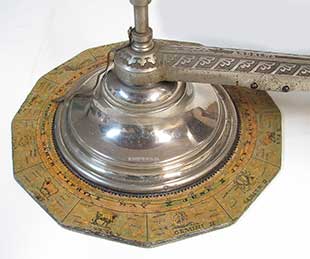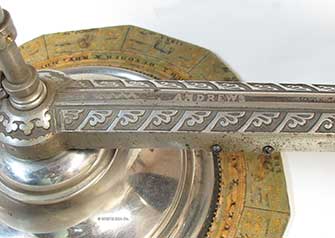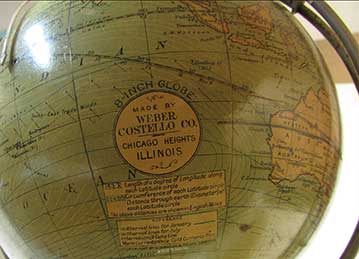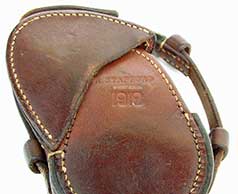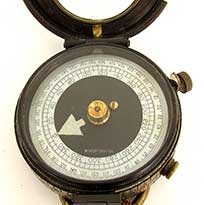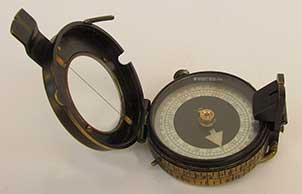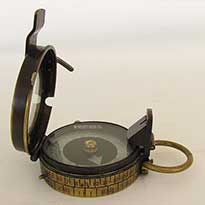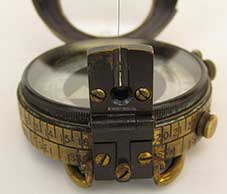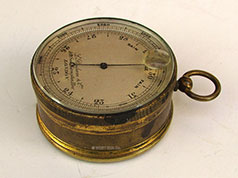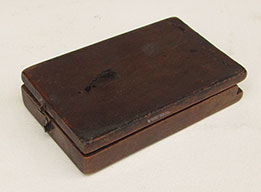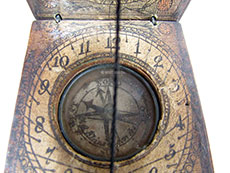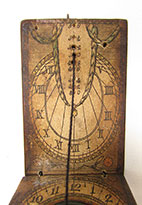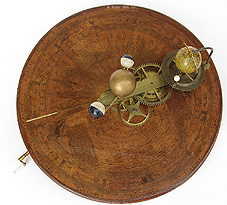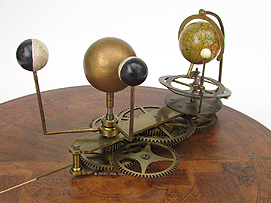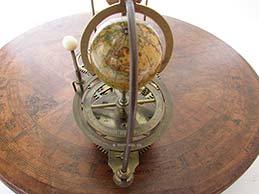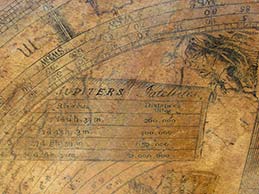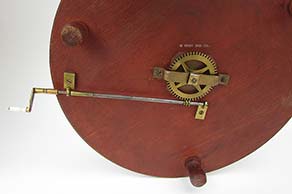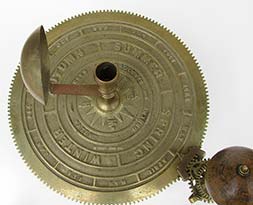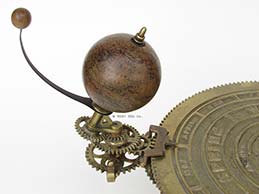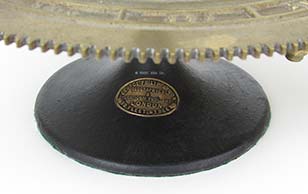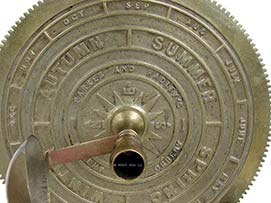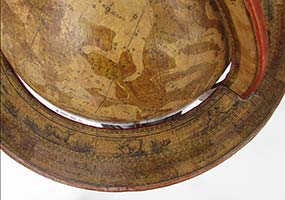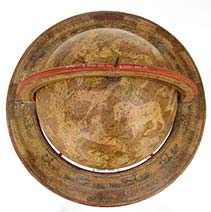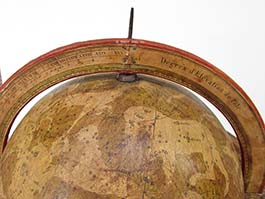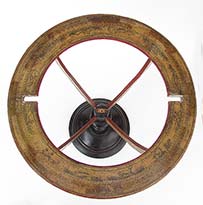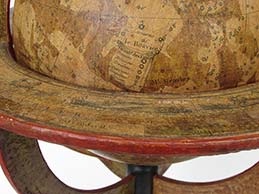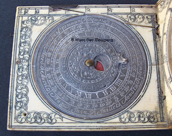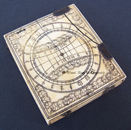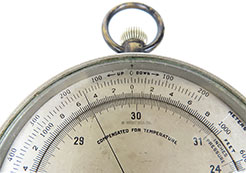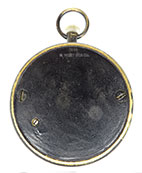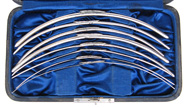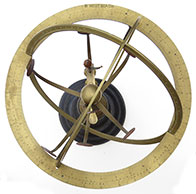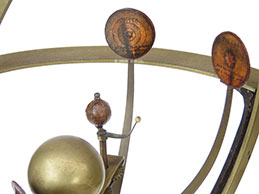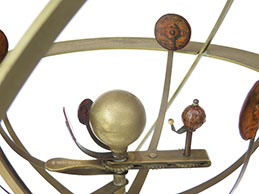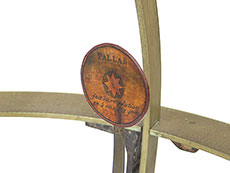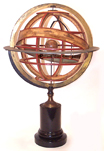9. Scientific & Medical
Prices in U.S. Dollars are in GREEN
 |
9.37 18TH C. COMPASS. Splendid early 1700’s traveler’s pocket compass of English manufacture. This especially nice example of a diptych (2 leaves or tablets in the form of a book) compass is made of rich mahogany hinged together with inlaid diamond-shaped brass fasteners. The very early style compass rose is engraved on paper with a starburst with the Cardinal and Intercardinal points of the compass identified. All 32 points of the compass rose are indicated. In an amazing feat of precision, the periphery is calibrated in single degrees of the compass marked by 10’s! And, in an unusual departure from the norm, North is depicted by a classic fleur de-lis on the right side of the compass body, rather than at the top. The designations “NE, E, SE, W, and NW” clearly indicate this compass was made for the English speaking market. The rose is ornately decorated with floral and linear elements. Also speaking to its age is the early type of compass needle which has an ornate, “horned” pivot. The card is protected under old wavy glass secured by a finely-turned brass bezel. This form of ring is identical to the objective ends of 17th and18th century telescopes! Exemplary of its quality this compass is equipped with a caging device which safely locks the needle when the lid is closed. A quality brass hook closure in the form of the number “7” assures the lid is tightly secured. 2 inches square by a mere ¾ of an inch thick. Amazing, actually unbelievably fine original condition! 395 |
 |
 |
| detail | closed |
 |
9.54 DENTIST’s TOOL. Fearsome mid-1800’s or earlier dental tooth extractor with a solid whalebone handle. Known as a “tooth key” this early-form medical instrument is hand-forged of iron with decorative elements. The working end pivots in order to firmly grip the hapless victim’s tooth which was removed using a twisting motion of the leveraged handle. Excellent original condition showing much age and actual use. Inconceivable in the modern era of science and medicine! 495 |
 |
 |
| detail | reverse |
 |
9.36 EARLY SUN DIAL. Authentic 18th century wooden diptych sundial made for the European market. This precision scientific device is made of an indigenous hardwood in 2 leaves like a book, hence the name “diptych.” The upper leaf is decorated with a sunburst, 2 flowers and a foliate design, all within a double circle. It contains a small pendulum bob on a string designed to show the unit level while in use. The bottom leaf contains a small compass under glass. The paper compass rose is engraved with the North pointing fleur-de-lis at about the 11 o’clock position, indicative of magnetic North in Europe during the late 18th and early 19th centuries. The East point is also decorated, indicative of that time period. The rose is marked in single points of the compass (32 in all). It is swept by its highly responsive compass needle with brass pivot. The string gnomon attaches to the upper and lower leaves. When properly oriented to North, the gnomon casts its shadow on the time of day indicated on the periphery of the compass, as stamped into the tablet -- 5 in the morning to 12, to 5 in the evening. The front of the tablet is stamped “AUTOR.” The top is deeply incised with the initials “J.S.” It is also marked “VERDACE illegible SUPERIOR (?)” Two small wire hooks and eyes hold the device open or closed. 3 inches long by 2 inches wide and 1 inch thick when closed. A very charming complete, functional scientific instrument over 200 years old! 495 |
 |
 |
| closed | lid |
 |
| dial |
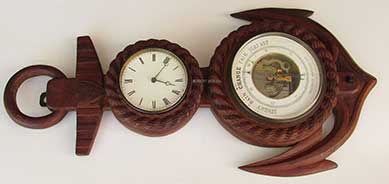 |
 |
 |
| clock | barometer |
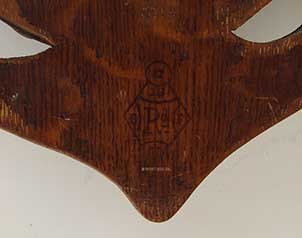 |
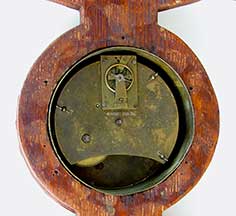 |
| registry mark | movement |
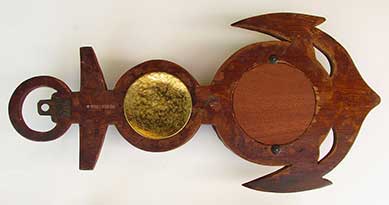 |
| back |
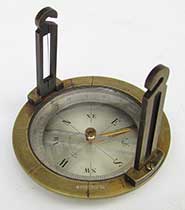 |
9.34 CASED SURVEYOR’s COMPASS. Late 19th century precision surveyor’s pocket compass of French manufacture, made for the Western market. This high quality pocket instrument is all brass made in two tiers. The bottom is a silvered brass compass rose with the Cardinal and Intercardinal points identified. In tiny letters below the “W” it is signed “Made In France.” The second tier has a surrounding silvered ring calibrated in single degrees marked by 10’s, 0 – 360. The high quality double-ended compass needle is supported on a brass bearing with an agate pivot. A caging device operated by a small button on the side between “E” and “SE” locks the needle in place during transport. The surround of the compass body is scored in sectors coinciding with the major compass points within. The two sight vanes align along the North/South axis. The peep vain is above the “S” with the hair line vane above “N”. Together they will sight and take a compass bearing of a distant object using the caging device to set the compass needle when sighted. The vanes fold into a positive position for use and neatly fold down when secured. Remarkably, this instrument comes complete in its original wooden carrying case with leather covering and velvet interior. It is hinged and secured with 2 early-style hook and eye closures. The compass measures 3 ¼ inches in diameter and is 3 inches tall overall with the vanes extended. The carrying case is 3 7/8 inches in diameter and 1 1/8 inches thick. Amazingly well-preserved showing good age and careful use. The compass is lively, accurate and the caging function works properly. A fine 1800’s scientific instrument at a guaranteed to sell low price. 349 |
 |
 |
| case | in case |
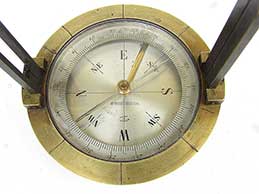 |
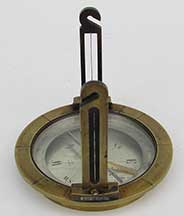 |
| dial | sight |
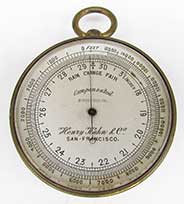 |
9.33 COMPENDIUM. Remarkable 19th century gentleman’s pocket compendium comprising 4 functions in one instrument! Barometer – altimeter – compass – thermometer. The aneroid barometer function features a silvered brass dial indicating atmospheric pressure with a huge range spanning 18 to 31 inches calibrated in whole inches divided down to 5/100ths. It is marked “RAIN, CHANGE and FAIR.” A delicate indicator needle points the reading. The dial is signed “Henry Kahn & Co. SAN FRANCISCO, Compensated.” The altimeter is embodied in the rotating rim surrounding the dial. The elevation is marked from 0 through an astounding 15,000 feet subdivided in 50 foot increments! The back of the instrument contains two more functions. A circular mercury thermometer which indicates the range of degrees Fahrenheit from 8 to 150. It is marked “FAHT” at the bottom of the dial next to the adjustment screw for setting the barometer. In the center is the magnetic compass under beveled glass. It indicates the standard 32 compass points on its mother-of-pearl card with the Cardinal and Intercardinal points identified. North is designated by a star above a lyre. The body of the instrument is gilt washed brass with a small pivoting suspension loop at the top. The rim of the altimeter is knurled for ease of setting the reading. The entire instrument is 2 inches in diameter and 7/8 inches thick. With the loop it measures 2 ¾ inches in length. Outstanding original condition showing careful use. ALL functions operate properly. 795 According to Kornelia Takacs in her comprehensive reference book ”Compass Chronicles,” 2010, Schiffer Books, Atglen, Pennsylvania, this compass was made in accordance with Samuel Barry Singer’s 1861 patent. The dry card dial is distinctively marked in half-black, half-white, providing a sharp contrast which was much easier to see in low light. A nearly identical compass dial is shown on page 42, dated at circa 1868. Two similar examples are shown, dating 1870 and 1880 respectively (p. 44). Of particular note is the fact that this American instrument, circa 1880, was designed to measure altitudes exceeding the tallest mountain in the United States at the time, that being California’s Mount Whitney at 14,505 feet of elevation. Long before air travel! |
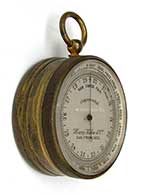 |
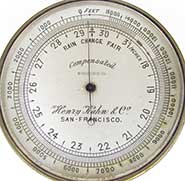 |
| perspective | dIAL Detail |
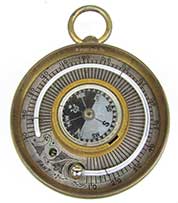 |
| BACK |
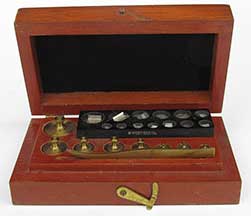 |
9.31 PRECISION SCALE WEIGHTS. Full set of balancing scale weights used for determining the exact weight of precious substances such as gold, diamonds and medicine. This pristine set contains 8 identified brass weights marked from one through 50 grams, with duplicate 2 and 10 gram weights. Then there is a cut black glass tray which contains thin metal strips ranging from 1 milligram up to 500 milligrams. The set is complete with its original brass tweezers. The total contents are neatly mounted in the substantial mahogany box with dark blue felt liner and brass hook closure. The set is signed by the maker as stamped into the case “F. HOPKIN & SON, JERSEY CITY, NJ.” 5 1/8 inches long by 3 inches wide and 1 ½ inches thick. It is amazing that this set has remained entirely intact in such good condition for over 100 years! 249 |
 |
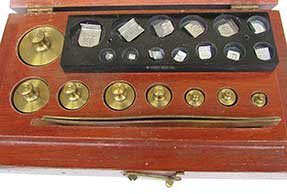 |
| box | detail |
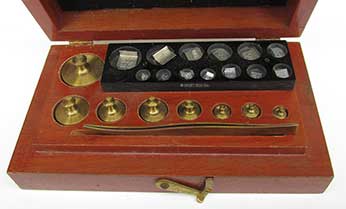 |
| set |
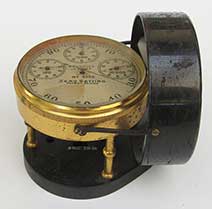 |
9.32 ANEMOMETER. Finest quality 19th century American instrument used to measure the volume of air passing through mines, sailing ships at sea and other “windy” applications. This precision all brass device has a silvered main dial with 3 subsidiary dials. It is marked “VELOCITY IN FEET No. 8839. ZERO SETTING Patent No. 3729.” The periphery of the dial is calibrated from 0 to 100 feet in single increments marked by 10’s. The inner dials read from 100 to 1,000 and from 1,000 to10,000. The entire dial is covered by a beveled glass crystal. The fan attaches to the mechanism in a perpendicular fashion and retains its substantial blackened brass cowling. It is extremely sensitive, registering the slightest air current. Circa 1900. 3 inches wide by 3 1/8 inches tall. The fan housing is 2 ¾ inches in diameter and the stout instrument base is 2 ¼ inches in diameter. Lovely original condition. A wonderful, virtually pristine example of early American technology in the emerging industrial age at a very reasonable price. 385 |
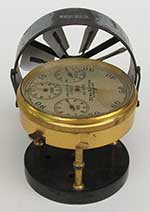 |
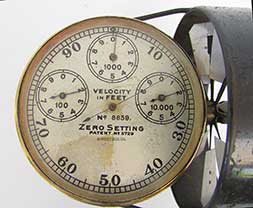 |
| perspective | dial |
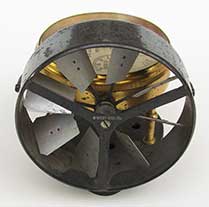 |
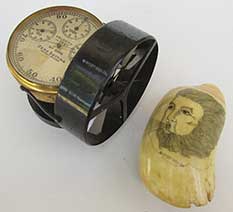 |
| fan | wind source |
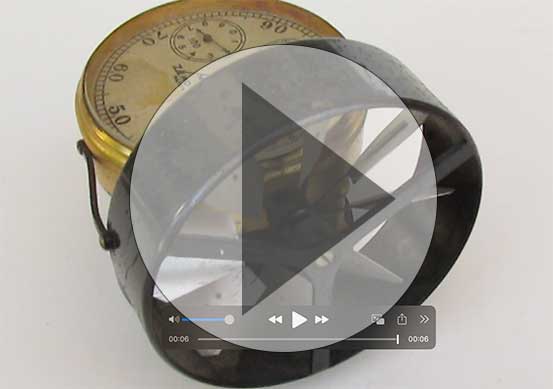 |
| movie |
 |
9.30 APOTHECARY CHEST. Unique 18th century sea captain’s medicine chest constructed of rich African mahogany with brass fittings. The upper section contains 6 hand-blown bottles with ground stoppers and telltale pontils on their bottoms. Three of the bottles have original non-descript contents. The section is divided by thin wooden panels chamfered to precisely fit the interior. The second tier contains 4 more bottles, 3 of which are hand-blown with stoppers. The 4th bottle is embossed “Booty CASH CHEMISTS.” The third and fourth tiers are precisely fitted with detailed dove-tailed drawers having ivory pulls. The top drawer has 4 fitted sliding covers. Two have labels: “Purified Nitre” and “Jalap Powder.” Of special note is the overall construction of the chest. It has a spring-loaded solid mahogany lid mounted on stop hinges which pops open when the skeleton key is unlocked. Interestingly, there is also a spring-loaded “keeper pin” which automatically locks the door when the lid is closed. As a secondary means of assured closure a hook and eye are provided on the right. Folding brass bail chronometer box handles adorn each side. The chest measures 8 by 7 inches on the top by 10 inches high and weighs 9 pounds. Excellent original condition, still functional after 250+ years! 1195 |
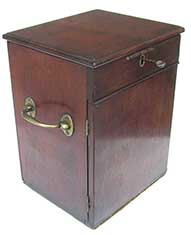 |
 |
| perspecive | front |
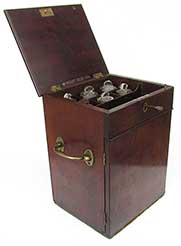 |
 |
| lid | upper contents |
 |
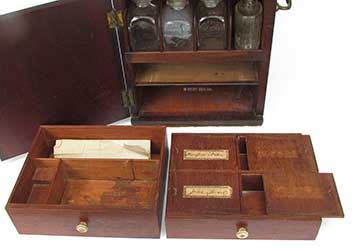 |
| full open | drawer detail |
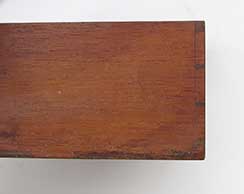 |
| dovetail |
 |
9.29 RENAISSANCE DIVIDERS. Super rare, genuine cartographer’s and/or architect’s dividers from the late 1600’s This museum piece is made of hand-finished cast iron featuring a splined joint at the apex and subtle decorative embellishments along the limbs. The tips are no longer sharp from centuries of use. Yet, the action is still very tight and smooth, opening to a width of 4 ½ inches. 4 3/8 inches long. Amazing original condition for such a working instrument over 350 years old! WAS $499 NOW! 249 From a major Pennsylvania collection of scientific instrument begun in the early 1960’s. The famed Dutch Renaissance painter Johannes Vermeer painted a portrait in 1668 entitled “The Cartographer,” which depicts a gentleman using such a divider on a map with a world globe in the background. |
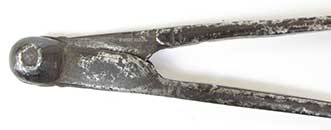 |
 |
| detail | reverse |
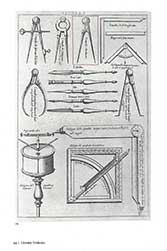 |
|
| plate | plate 2 |
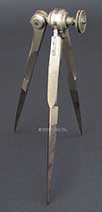 |
9.28 3-LEGGED DIVIDERS. Rare, original set of 3-legged dividers as used by mariners and cartographers in the 1800’s and earlier. This superb set is unsigned but is likely of German or English origin. It is absolutely the finest quality ever made. The body is German silver (non-metallic) with polished steel tips. The apex of the 3 limbs is a complicated pivot. Two are like a regular pair of hand dividers with splined joints opening and closing in a straight line. The addition of a third limb connected by a ball and socket allows the instrument to describe a multidirectional plane necessary in measuring the curvature of a globe. The quality of its precision cannot be overstated. The joints are smooth, tight and beautifully-finished. Speaking to its age, the ball joint has a small washer with 2 telltale holes for tightening, rather than a screw slot. Such a feature is indicative of 19th century and earlier manufacture. In addition, the instrument has a double knurled thumb screw which, when tightened, locks all three prongs in position. A wonderfully clever complication. 5 ¼ inches long by 1 ¼ inches wide at the pivots. Fabulous original condition. The best! 349 |
 |
 |
| detail | closed |
 |
9.27 AMERICAN POCKET COMPASS. Turn-of-the-century traveler’s pocket compass constructed in 2 leaves of wood hinged together. Known as a “diptych” compass, this device has a silvered brass compass in 2 tiers. The bottom is engraved with the cardinal points of the compass with a star denoting north. It is signed “W. & L.E. Gurley Troy.N.Y. ”The upper tier is marked in single degrees running counterclockwise from 0 at north to 359 marked in 10’s. The high quality compass needle has a jeweled pivot and is balanced for accuracy on the southern limb. A high quality caging device locks the needle in place automatically when the lid is closed. A “Lubbers line” is scribed in the lid for sighting. The lid fits snugly on its two hinges and is held by a small pivoting hook. Outstanding original condition. The compass is lively and extremely accurate. 279 W. & L.E. Gurley are perhaps the best known surveying instrument makers in American history. The Gurley name goes back as far as Ephrain Gurley who in 1813 started an iron foundry in Troy, New York. In 1851 Lewis Gurley began a partnership with his brother William. In 1852 they founded the company of W. & L. E. Gurley, not far from where their uncle Ephrain began his work. They advertised as manufacturers of compasses, theodolites, leveling instruments and “apparatus to illustrate the principles of Philosophy.” A fire destroyed their workshop in 1862, but it was quickly rebuilt that same year. Both men were active in the civic activities in their community. William Frank Gurley, son of Lewis began his work in 1882. He became a partner of W. & L.E. Gurley upon the death of his uncle in 1887. The company was incorporated under the name of “W. & L.E Gurley” on October 18, 1899. William Frank died in 1915, but the company carried on under the same name to this day. (Charles E. Smart, “The Makers of Surveying Instruments in America Since 1700,” 1962, Regal Art Press, Troy, New York). |
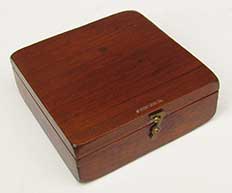 |
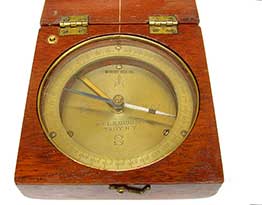 |
| closed | open |
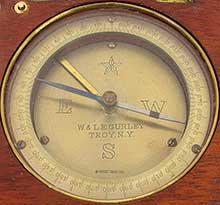 |
| dial |
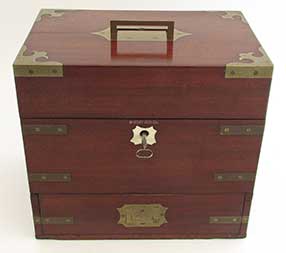 |
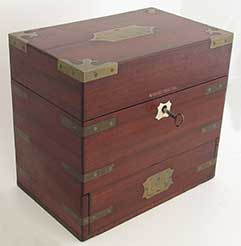 |
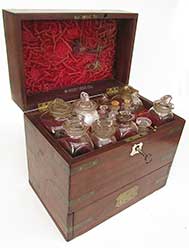 |
| perspective | open |
 |
 |
| side | contents |
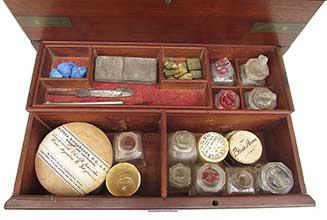 |
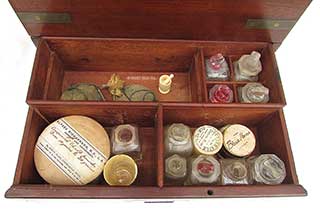 |
| drawer | lower tier |
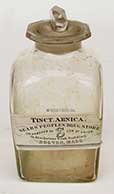 |
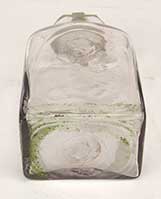 |
| bottle | pointil |
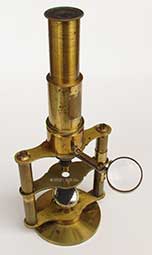 |
9.25 ANTIQUE MICROSCOPE. Genuine 1840 high quality continental microscope complete in its original box with accessories. This professional scientific instrument is all bras with all of its original optics and accessories. The unusual configuration has a knurled knob connected to a rack and pinion platform which raises the stage for focusing, rather than the typical method of moving the optics while the specimen remains firm. It has a solid lead base for stability covered by brass which supports the pivoting substage concave mirror for illumination. Above, an articulated magnifying lens is attached to the body of the scope. The instrument comes complete in its original fitted mahogany case measuring 10 ½ inches long by 5 ¼ inches wide and 3 ½ inches thick. The hinged case has it original skeleton lock with inlaid ebony diamond-shaped escutcheon and is complete with 2 additional objectives and circular glass magnifier. The box contains the business card of the last owner, “James Lincoln Hauser, M.D.” This rare scientific instrument is in excellent overall condition. The surfaces retain about 80 % of their lacquer without significant discoloration. The form-fitting mahogany box is very sound but it does have 2 significant age cracks in the lid. Included in this offering are 8 period prepared microscope slides all in excellent condition. This is an incredible value for a quality instrument of its type over 180 years old! WAS $895 NOW! 295 |
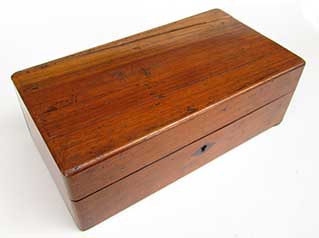 |
 |
| box | in box |
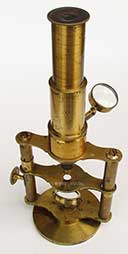 |
 |
| reverse | slides |
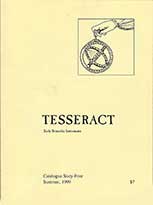 |
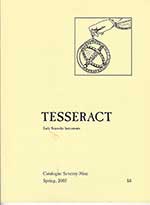 |
| 64 | 79 |
9.22 TWO ‘TESSERACT’ CATALOGS. This company was certainly the preeminent purveyor of the finest scientific instruments available at the time of their publication. Dr. Cofeen was an eminent specialist in all forms of scientific instruments from navigation to medicine. His research and documentation are unexcelled in modern day treatments of the subject. These two catalogs, from 1999 and 2005 document the state of scientific collecting of their time. A wonderful window into the evolution of values. Offered at the same prices they sold for at the time of publication! Both for only 14 Shipped First Class Mail |
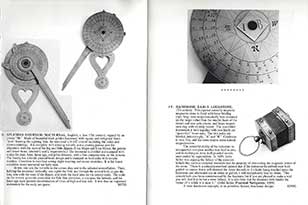 |
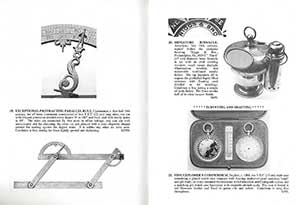 |
| 64-2 | 79-2 |
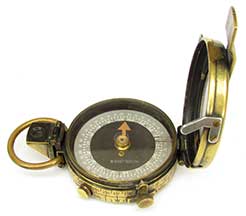 |
9.21 MARCHING COMPASS. Very high quality pocket compass made for the American Corps of Engineers for World War I. According to Kronelia Takacs in her monumental reference work “Compass Chronicles,” 2010 Schiffer Publishing, Atglen, PA, pages 73 - 74, a number of British firms manufactured military compasses in WWI. The most widely used was the Verner’s Pattern prismatic compass, Mark VI, made as early as 1905. The dial has 2 scales. The inner area is graduated every 5o, numbered every 20o. The numbers on the outer edge are reversed to be read through the prism and they start form South towards West. The edge of the dial is marked every 1o. North is indicated by a prominent arrow running from the center. The high quality pivot is jeweled. This all brass compass has a hinged lid with glazed port and line of sight. When the lid is opened a clever prong engages the compass’ caging device freeing the card. The pivoting prism can then be move into position to sight the target through the glazed lid while simultaneously reading the compass bearing! The surroundings sides of this complicated device is marked in 5o increments numbered by 10’s 0 through 34 and in ½ points of the compass rose with the cardinal, intercardinal and subcardinal points of the compass identified. The top face of the compass body is marked “ENGINEER CORPS U.S.” The bottom is backed with a rubber insulator and is marked “C.E. (Corps of Engineers) 1918” with the serial number. The top has a pivoting brass suspension loop. This precision instrument comes in its original leather carrying case with closure. The case has a belt loop for attachment. The compass body is 2 ¼ inches in diameter. The case measures 3 ¾ x 2 ½ x 1 ¼. Remarkable original condition. 249 |
 |
 |
| open | with case |
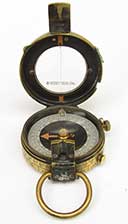 |
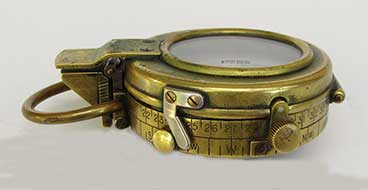 |
| sight | side |
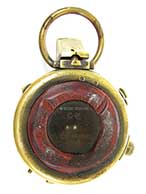 |
| maker date |
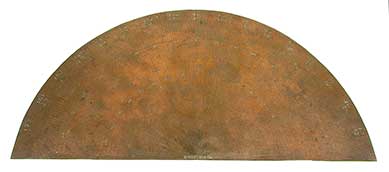 |
9.17 PRECISION PROTRACTOR. Unique antique protractor hand-inscribed from 0 to 180 degrees left and right. This amazing device is made of sheet copper – very unusual in that virtually all such instruments of its type were made of brass. This is probably because copper, an elemental metal, is very malleable and easily worked while being less susceptible to corrosion. This complicated protractor has no less than 20 semi-circular bands radiating from its center. The outer most band on the periphery is calibrated in single degrees marked by 10's in a counterclockwise direction. The next band is marked in 5 degree increments running clockwise. There are two more bands towards the center each calibrated in single degrees, 0 centered, marked by 10's, running 90 degrees left and right. At the locus, marked by a very tiny indent, the lines are so finely concentrated as to be the width of a human hair! This early instrument likely dates to the late 1700's and was probably not made by a professional scientific instrument maker, but rather a skilled ship's navigator or carpenter. 11 ¾ inches wide by 5 7/8 inches high and less than 1/16 inch thick. Excellent original condition showing great age and use, but no abuse. A true rarity! 475 |
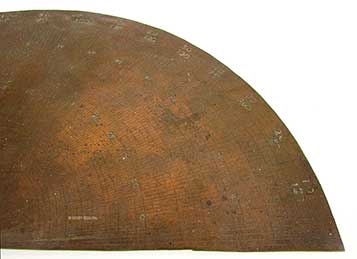 |
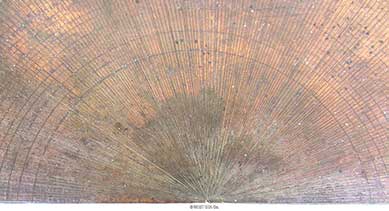 |
| detail | locus |
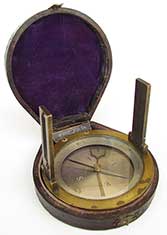 |
9.20 PORTABLE SURVEYOR's SIGHTING COMPASS. Very high quality late 19th century surveyor's pocket compass of French manufacture. This genuine scientific instrument has a surprising array of multiple features. It is two–tiered. There is a magnetic compass showing direction on the upper scale of the silvered brass dial calibrated in single degrees from 0 to 360 marked by 10's. The compass needle has an agate pivot, indicative of its quality. The lower tier on the Western edge is marked in degrees of declination in single degree increments starting with 90 at North, then 0 at West increasing again to 90 South. The scale is overlaid by a very fine brass inclinometer which indicates single degrees. Yet a third function is the ability to sight a bearing using the 2 folding sighting vanes in blackened brass finish on the North and South sectors. The brass was blackened to negate the effects of the sun's glare. For carrying, the compass is equipped with a compass needle caging device at the East point. For determining inclination there is a flat bar attached to compass body on the West end for alignment with the surface being measured. Although unmarked this precision instrument is undoubtedly French. This complicated device is all brass and fits snugly into its velvet lined case of wood overlaid by Moroccan leather. Complete with original brass snap closure. The instrument measures 3 5/8 inches in diameter and 3 7/8 inches wide overall. The case is 4 ¼ inches in diameter and 1 ½ inches thick. This is a multi-functional compendium of the highest quality, in remarkable condition, well over 130 years old! It is the first of its type we have encountered in such beautiful condition with its original pristine wood and leather case with velvet lining. 669 |
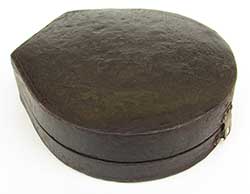 |
 |
| case | in case |
 |
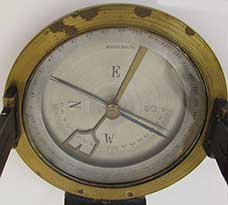 |
| instrument | dial |
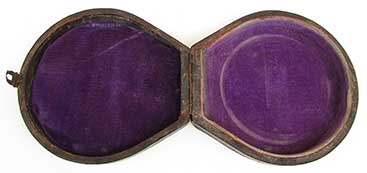 |
 |
| case open | case bottom |
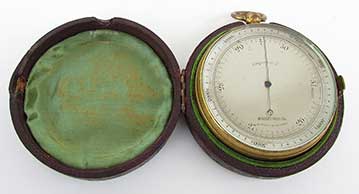 |
9.19 ALTIMETER/BAROMETER. Very nice large 19th century gentleman's traveling weather barometer of English manufacture with the dual function of being an altimeter. This larger than average portable instrument is in the form of an antique pocket watch with bow. The silvered brass dial is hand-engraved. It is calibrated from 25.5 to 31 inches of barometric pressure, divided down to 2/100ths of an inch. It is marked "Compensated" and "Made in England" The outer rim of the dial is marked in "FEET" from 0 to 5,000 divided down to amazing 20 foot increments! To set and record a reading the rim revolves. This is provided with pinpoint accuracy by the extremely fine steel indicator needle which is little more than a hair's width in diameter! The solid brass case retains 95% of its lovely gilt finish This instrument is complete within its hinged wooden case with silk and satin-lining and Moroccan leather cover. A small spring-loaded lever with brass button latch secures the case with a snap fit when closed. 3 ¼ inches in diameter and 1 ¼ inches thick. The dial itself measures 2 ½ inches in diameter. Fully functional and accurate. Unusually fine original condition considering this is a working scientific instrument over 100 years old! 495 |
 |
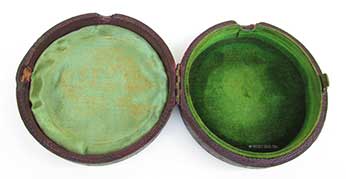 |
| in case | case open |
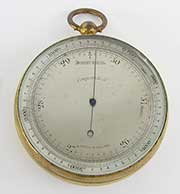 |
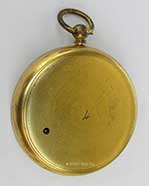 |
| barometer | back |
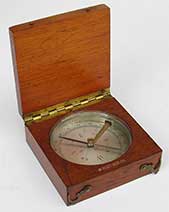 |
9.18 WOODEN DIPTYCH COMPASS. Fine, late 19th century folding pocket compass of French manufacture. This quality traveler's compass is constructed of two hinged wooden tablets, the body of which bears a silvered brass compass protected by old wavy glass. The compass rose shows the cardinal and intercardinal points of the compass. The periphery is calibrated in single degrees 0 – 360 marked by 10's. The compass deviation for late 19th century Europe is indicated by a feathered arrow just West of North. The center is finely marked "MADE IN FRANCE." Speaking to its quality the delicate double ended compass needle has a ruby pivot. The compass has a cleaver caging device which locks the needle in place when the lid is closed. The all brass piano-type hinge assures a secure closure aided by 2 delicate brass hooks pivoting on the front. 3 inches square by 1 3/16 inches thick. Excellent original condition showing good age. The compass is lively and accurate. This is an excellent buy! 199 |
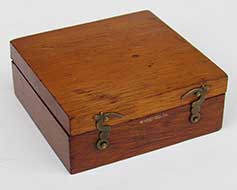 |
 |
| box | dial |
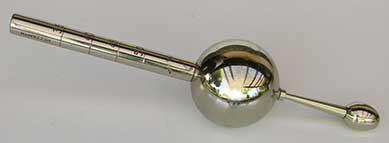
|
9.08 HYDROMETER FLOAT. Pristine precision shipboard scientific instrument used to determine the specific gravity of a liquid, in this case the purity of water in the ship's boilers. This nickel-plated brass float is marked "Hezzanith, Made In England 60o" and is calibrated from .0035 to .0050, representing the difference in the ratio of the liquid being tested to pure water in thousandths. 0.000 being pure water. In another application a very similar instrument was routinely used in the distilling industry to determine the proof of spirits (alcohol and water). 39 |
degreeS |
maker |
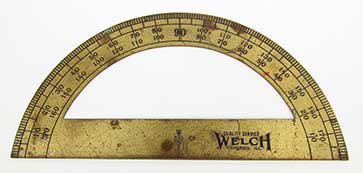
|
9.09 PROTRACTOR. Small, all brass precision protractor made by the famous scientific company "WELCH Quality Service, Chicago, Ill." as signed on the front. It reads 180 degrees left or right in single degree increments. The focus on the lower limb is marked with a fleur-de-lis. 4 ¼ inches wide by 2 inches high. Good original condition showing actual use. 10 William Welch founded an educational supply company in Chicago in 1880. In 1906 the Welch Scientific Instrument Company was established. Among other things Welch supplied the U.S. Navy with mercury stick barometers during World War II. |
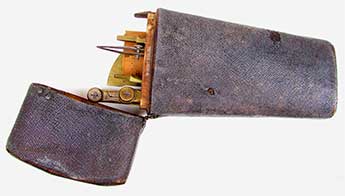
|
9.05 SHARKSKIN DRAFTING SET. Late 18th or very early 19th century draftsman's pocket drawing instrument compendium. This precise, early hand-made set has 7 components consisting of a boxwood logarithmic scale, hand-held inking pen, a compass inking pen, a long divider point, a pair of fixed dividers, a compass divider with interchangeable points and a brass protractor. The entire exterior is covered in thick, durable sharkskin. There are a couple of minor scuffs/losses but overall it is in good, sound condition. The hinged lid works properly and closes snugly on its button latch. 6 ¾ inches long by 3 inches wide at the widest and 1 inch thick. A rarity. 695 |
case |
contents |
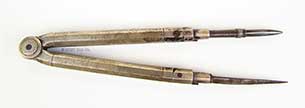
|
9.99 DRAUGHTSMAN's INKER. A scarce example of a mechanical draftsman's compass with inking nib made by one of England's foremost 18th and early 19th century instrument makers. The limb of one is hand-engraved "W & S, JONES, 30 Holborn London." These hand-crafted brass dividers have steel tips precisely mortised into the brass arms of the compass. It measures 4 ¾ inches long. But the tips are both articulated to expand their functional radius to about 6 inches. Excellent original condition. Rare to find such a small instrument signed, especially by such important makers. In these inflationary times a real bargain! 139 |
owner |
signature |

|
9.97/13.91 BUTTERFIELD SUN DIAL. An astounding offering! This is a late 16th or very early 17th century cased pocket sun dial of the type known as a Butterfield dial, invented by Britisher turned Frenchman Michael Butterfield circa 1690. This stunning surviving example is all brass made by "LeMaire Fils, Paris" as beautifully-engraved just below the compass. The very early form compass needle rides over the engraved compass rose indicating the cardinal and intercardinal points of the compass marked N, S, and O, with the north point indicated by a fleur-de-lis. The dial is constructed with a hinged gnomon, the angle of which can be adjusted for latitude as indicated by the beak of a bird on a scale reading from 40 to 60 divided in single degree increments. The upright gnomon is spring-loaded and will lie flat on the body of dial on either side. The dial plate has 3 beautifully-engraved chapter rings for latitudes of 43, 46, 49, and on the extreme periphery 52 degrees, these encompassing the area between Gibraltar and the Shetland Islands. The time indications in whole hours are marked in Roman numerals from 4 A.M. to 8 P.M. divided by 15 minute increments. The reverse of the dial is engraved with at least 23 latitudes of prominent European cities of the time. Incredibly this superb instrument comes in its original felt-lined wooden case with its durable fish skin cover, all of which are in a remarkable original state of near pristine preservation! The octagonal dial measures 3 ¼ inches long by 2 5/8 inches wide, fitting neatly in its case measuring 3 ½ inches long by 3 inches wide. The hinged lid of the case closes with a button latch, further secured by 2 hook and eye closures. A remarkable scientific instrument in unheard of original condition over 300 years old! Museum quality of the first order. 2879 |
case |
case bottom |
in case |
interior |
perspective |
bottom |
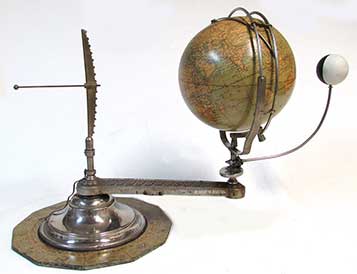
|
perspective |
base |
mechanism |
north america |
maker |
globe maker |
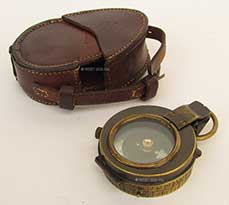
|
9.94 MARCHING COMPASS. World War I vintage pocket sighting compass as issued to Allied troops of that era. This example is signed “S. MORDAN & CO.’ dated “1918” and stamped with the British broad arrow. The precision all brass device has a mother-of-pearl compass card with an agate pivot. It is calibrated in 5 degree increments marked by 10’s on the inner circle and single degrees marked by 10’s on the outer circle. These numbers are backwards so that they can be read upright when using the prismatic view finder. In use the sight pivots into place. A small slot at the top can be aligned with the sighting line in the glass cover, while simultaneously reading the bearing of the object sighted. The knurled glass bezel covering the compass card can be rotated or locked into place. A small caging device on the side of the body locks the compass in place manually when not in use. Closing the cover also locks the compass. A pivoting brass ring is provided for suspension. The entire compass fits neatly into its heavy duty sewn leather case impressed “A. STAFFORD 1918.” The case has a strap with brass buckle for closure. The entire presentation is in an amazing state of original preservation. The compass is lively and accurate and the optics of the sight are clear and bright. The compass measures 2 ¼ inches in diameter. The leather case is 4 inches long by 2 ½ inches wide and 1 ¼ inches thick. A very ingeniously-devised device still as nice as it was made over 100 years ago! 219 |
case |
case maker |
compass |
open |
side view |
observers view |
maker |
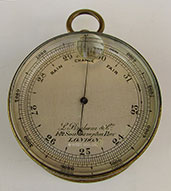
|
9.90 / 22.40 POCKET COMPENDIUM. Remarkable 2nd half of the 19th century English gentleman’s traveling instrument containing FOUR scientific functions in one! This compact device is signed in engraved script “L. Braham & Co. 142 Southampton Row LONDON.” On the front it features 2 functions: a weather barometer and an altimeter. The barometer function, reading effectively from 28 to 31 inches of atmospheric pressure, is marked “RAIN, CHANGE, and FAIR.” The scale is calibrated in inches of mercury down to 5/100ths. The second function, the altimeter, indicates the altitude in feet from sea level to 8000 feet in 50 foot increments marked by thousand’s. Both are indicated by a very fine needle pointer. To aid in the reading, the revolving knurled bezel is equipped with a built-in “bubble” magnifier. The reverse of this amazing instrument has a curved mercury thermometer reading from -5 to 165 degrees Fahrenheit. Central to the display is a functional compass made on Singer’s Patent. The high quality card is made of mother of pearl with a central agate pivot. The compass is marked in single points of the compass with the cardinal and intercardinal points identified. North is indicated by a lyre symbol. Remarkably this miniature compass has a caging device operated by a tiny lever to lock the card in place when not in use! The instrument is solid brass with traces of original gilding. It has a pivoting suspension loop at the top and a small aperture at the bottom for setting the barometer reading. A mere 2 inches in diameter and 1 inch thick. All functions are working and very accurate. The best of its type we have seen in our 40 years. SOLD |
perspective |
thermometer - Compass |

|
9.58 EARLY ENGLISH THERMOMETER. Genuine mid-19th century gentleman’s traveling pocket thermometer with ivory scale signed by the maker “CARTER, EXETER” at the top. This antique mercury bulb thermometer is marked in single degrees Fahrenheit from 0 to 110 with the classic notations, “FREEZING, TEMPERATE, SUM,’R HEAT and BLOOD HEAT.” It is housed in its original wooden case, lined in silk and covered in Moroccan leather. The hinged case closes on a positive button latch and is equipped with a pivoting brass eyelet at the top for hanging. The ivory scale also has a silk ribbon rove through the top for hanging independent of the case. 6 ¼ inches long, 1 ¼ inches wide and ½ inch thick. Untouched original condition showing expected wear from careful use. Functional and accurate. 249 |
THERMOMETER |
CASE |
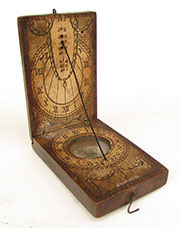
|
9.86 VERY EARLY SUN DIAL. Mid 17th to very early 18th century gentleman’s pocket sun dial of German manufacture. This rich hardwood diptych (two part) dial has very old engraved paper tablets. The lower limb houses the sunken magnetic compass with the inscriptions “NORD” (north), “O” (east), “SUD” (south) and “WEST” (west) at the ends of. It is signed on the lower half of the compass rose “G. Kleine en ger fecit.” A prominent arrow points in the direction of the actual North Pole corrected for magnetic variation of the time. Surrounding the compass on the lower tablet are the hours of the day beginning with 4 in the morning on the southern point and ending with 8 in the evening next to it at the attachment point of the gnomon thread. Radiating from the center of the compass are lines indicating quarter hours. The bottom of the tablet is adorned with a sash and decorative architectural elements. The upper tablet has another time dial with Roman numerals from V to VII, again marked in 15 minute intervals. What is remarkable about this dial is that the gnomon thread can be adjusted for the user’s Latitude from 40 degrees North to 56 degrees in 2 degree increments. This means the dial was made for use from Rome, Italy to Dundee, Scotland! The upper tablet is also decorated with a sash, architectural designs and polychromed roses. The silk thread gnomon is likely later. The dial measures 2 5/8 by 1 5/8 and is ½ inches thick. Condition of this domestic scientific instrument is remarkable, given its 300+ year age. The compass is lively and the paper tablets are in excellent condition showing toning from age but no tears or losses. The old original wavy glass is in place. The simple hardware consisting of two hand-forged snipe hinges and a hook and eye closure are in excellent, functional condition. 595 |
CASE |
COMPASS |
UPPER TABLET |

|
9.76 18th CENTURY ORRERY by FAMOUS MAKERS. Important, exceptionally rare late 1700’s mechanical model of the solar system made by the famous English scientific instrument makers W. & S. Jones, London as signed in two blocks near the center, “Designed for the NEW PORTABLE ORRIERIES by W. JONES” -- and “Made and fold (sic) by W. & S. JONES 30 Holborn, LONDON,” with each block held by winged angels. This working apparatus consists of a wooden turntable supported on tripodal feet overlaid with a comprehensive lithographed view of the cosmos from an 18th century perspective. The central title reads “A TABLE of the principal AFFECTIONS of the PLANETS Jany 1st 1794 Published as the Act directs by W. & S. Jones.” Above it is the legend reading “ANNO 1794” listing the planets “MERCURY, VENUS, EARTH MARS, JUPITER, and SATURN” with a table indicating “Mean Distance, Period of revolutions, Diurnal rotations, Diameters and Greatest elongation of planets” for each. To the left is a table listing SATURN’S Satellites” as held by a scholar sitting next to a globe. On the right is a table listing “JUPITER’S Satellites” as held by a robed scholar pointing to the table. Below is a large hemispherical chart depicting the relative positions of the planets from the year 1796 through 1810 entitled “THE SOLAR SYSTEM.” Encircling these central vignettes (moving outward) are the individual degrees of the compass, followed by 2 bands of sectors, each containing 90 degree quadrants marked by 5’s and running from 0 to 90, then 90 to 0. Extending outward from them are the cardinal, intercardinal and sub-intercardinal points of the compass. Next are the 12 signs of the Zodiac with their respective characters charmingly depicted. Outward from these is an interpolative degree scale divided down to ½ degree in units of 30 degrees each. Finally the outer periphery is divided into the identified 12 months of the year. If all of this weren’t amazing enough, the equally fascinating aspect of this mechanism is its geared clockwork depicting the Sun, Mercury, Venus, Earth and its moon. Through the complex gearing system, operated by an ivory-handled brass crank on the rim, each planet is shown to revolve about the sun. In addition the earth turns on its axis as the moon revolves around it. There are 2 engraved brass rings below the earth. The bottom ring shows the phases of the moon, while the upper ring is divided into 15 degree sectors marked with the traditional signs of the Zodiac. Charmingly, the Earth is made using traditional chromolithographed paper gores. The makers’ name “JONES LONDON” appears in the Pacific Ocean. Simulating day and night, a crescent shaped brass light curtain encircles the Earth while the ivory moon revolves on a tilted plane in keeping with the Tropics of Cancer and Capricorn. The entire apparatus is in an amazing state of original preservation with obvious signs of age, careful use and minor restoration. 12 5/8 inches in diameter. Completely functional. Museum quality of the first order. Price Request William Jones II was born in 1762 and began his work as a philosophical, mathematical and scientific instrument maker on Holborn Street, London in 1787. In 1792 he joined with his brother Samuel in a partnership to form the firm of W. & S. Jones. That well known, highly respected and very prominent instrument making firm flourished until 1832 at 30 Holborn, London. They were known to have manufactured and sold planetariums and sun dials among other instruments. (Gloria Clifton, “Dictionary of British Scientific Instrument Makers 1550-1851,” page 153.) |
A virtually identical example of this early orrerey was offered by "Tesseract" of Hastings-on-Hudson, New York as item number 4, in their catalog 64, Winter 1999/2000 for $22,500.
Video 1 |
top |
planets |
earth - moon |
jupiter |
underside |
makers |
CoMp |
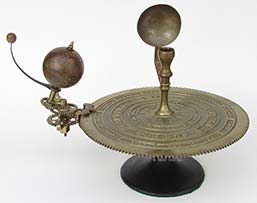
|
9.78 RARE ENGLISH ORRERY. Mid-1800’s mechanical planetary model depicting the earth and its moon revolving around the sun. This beautifully-constructed mechanism features a heavy cast brass bedplate mounted atop a graceful cast iron base. Affixed to the base is the embossed oval brass maker’s label reading, “George Philip & Son Geographical & Educational Publishers LONDON 32 Fleet Street.” The brass bedplate is cast in high relief with a compass rose in the center encircled by the inscription, “PARKES & HADLEY’S PATENT ORREREY.” Surrounding it are concentric rings indicating the seasons then the months of the year. Stamped on the periphery is a pretzel-shaped logo pierced by an arrow reading “SALTER,” the casting foundry. The perimeter of the plate exhibits very finely-cut gear teeth. These mesh with a series of gears at the end of a rotating arm which support and give motion to the sun and its moon. The mechanism is so-designed that the earth revolves 30 times as it passes each month on the bedplate while the moon completes a full orbit around the earth! The earth is constructed in the traditional was with paper gores covering a plaster core. The moon is paint wood. The top center of the device has brass candle holder to mimic the sun. Behind is a silvered parabolic reflector. This fascinating device stands 9 ¾ inches high by 13 ¾ inches wide at the widest. The bedplate is 10 inches in diameter. This Orrerey is in excellent original condition and operates properly and smoothly. Price Request |
perspective |
earth and moon |
signature |
second signature |
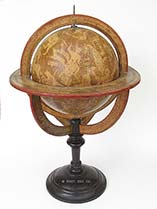
|
9.81 EARLY CELESTIAL GLOBE. Very important 18th century celestial globe made by the French master Jean Fortin (1750-1831), as signed on the International Dateline (180th meridian) “POSITION des Etoiles Fixes F. Année 1780 Par le Sr Fortin Ingen Geogr. Paris.” Above it, in the Northern hemisphere, just to the right is a cartouche reading “Grandr des Etoiles” the key to the magnitude of the stars depicted, running from “Premiere, Deaucime, Troisieme, Quatrieme and Cinqemiene and Sireme” and ending in “Nebuleu.” The constellations and stars so designated are done in a most precise and scientific way, with the bodies of the constellations depicted in dark brown against the lighter tan background of the globe. Literally hundreds, approaching thousands, of stars are depicted as are the equator, Tropic of Cancer and the Tropic of Capricorn. There are several other features, too numerous to relate in this description. The supporting Meridian ring is marked in single degree noting “Degres of Elevation due Pole” and also “Nonbre de Climats.” It is boldly marked “MERIDIEN.” The equally impressive stand has an equatorial ring, the inner circle of which is marked in single degrees. Next is the depiction of the signs of the Zodiac with the likenesses of the representative characters. Extending outward, the next is another alternating degree scale. Further are the divisions of months. Finally, on the outer rim are the European markings for the intercardinal markings of the compass. This globe was constructed in the traditional way using a plaster of Paris core overlaid by chromolithographed paper gores. The wooden stand, meridian and equatorial rings are constructed of wood, again overlaid with chromolithographed paper. The turned stand and base are ebonized hardwood. The hand-written inscription “globe celest” is written in chalk on the bottom. The globe itself measures 8 ½ inches in diameter. It is 13 inches wide and 20 inches tall overall. Aside from a few areas darkened with age, the entire presentation is in an absolutely remarkable state of original preservation after nearly 240 years. Museum quality of the finest order! Price Request |
detail |
perspective |
pole |
equatorial ring |
magnitudes |
signature |
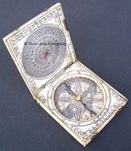
|
9.02 POCKET SUN DIAL. Rare, incredibly old sun dial made entirely of ivory with pewter plates and brass fittings. This amazing relic is of French originand represents what is known as a “Dieppe Magnetic Azimuth or Bloud-type dial.” It is attributed to the early Parisian dial maker Jacques Senecal and dates circa 1660! It is of the diptych type, meaning it has two leaves or tablets, hinged in the middle. The outside top of the upper leaf is equipped with a pewter equinoctial dial for telling time by means of a pin gnomon. The inner side is fitted with a lunar volvelle, allowing it to be used to determine the time at night when the moon was visible. The main part of the dial occupies the lower leaf of the diptych. A recessed bowl accommodates a delicate magnetic needle suspended on a pyramidal brass pivot. Cleverly, this dial actually represents a form of mechanical computer. The underside of the leaf holds a rotating disc engraved with the months and days of the year. It is connected to the interior hour scale below the compass needle which acts as the gnomon. Rotating the outer disc to the corresponding day moves the hour scale within setting it to the proper “altitude” for the time of year. A typical horizontal dial with string gnomon is also provided, with the hours engraved in the ivory around the periphery of the compass rose. In the bottom plate of the dial there is a finely-engraved paper card, the outer edge of which is marked in degrees by tens in four quadrants. Within is an 8-pointed star with a fleur-de-lis at the North point. The other star points are marked with the latitudes of important European cities such as “Paris, Venise, Rheims, Roma, Londre,” etc. It is alsoequipped with a clever pivoting brass “stay” which holds the lid open, fitting neatly into a recessed slot when not in use. This lovely instrument is profusely engraved with decorative pinwheel elements on the periphery of each of its tablets, inside and out. There are two very early pewter repairs in the lid to stabilize an age crack, and the very tip of one of the tiny brass hooks is off. Otherwise this 350 year old instrument is in amazing condition for its age. A museum piece! SOLD Literature: Hester Higton, “Sundials, An Illustrated History,” 2001, Philip Wilson Publishers, Ltd., London. Page 89 depicts a very similardial described as, “Dieppe magnetic azimuth dial by Jacques Senecal, c. 1660. The inside of this dial has a lunar vovelle in the upper leaf and the main dialset into the lower one. Collection of the National Maritime Museum, London.” This sun dial represents the oldest antique we have ever offered in our 35 yearsin business. |
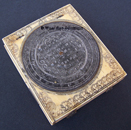
|
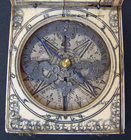
|
LUNAR VOLVELLE |
OUTER DIAL |
9.47 AMERICAN PRECISION BAROMETER / ALTIMETER. Very highest quality surveyor’s portable barometer and altimeter. This all brass precision devise has 2 silvered brass dials, The stationary center dial is marked from 24 to 31 inches of mercury calibrated in 2/100th increments and marked “INCHES PRESSURE.” It is additionally marked “Compensated For Temperature” at the top and is signed “Taylor Instrument Company, Rochester, N.Y. – U.S.A. E.D. No. 4226.” The outer dial rotates by means of the stem wind pocket watch feature at the top. On the periphery it is calibrated in “METERS” from 0 to 1800 in 10’s of meters. The inner scale is marked in “FEET” from -1000 to 6000 feet in 20 foot increments. Interestingly then, this instrument was designed to also be used in the few places on earth below sea level and in mines! The knurled outer rim of the barometer revolves to set a very fine needle pinpointing changes in the reading. The dial is protected by a beveled glass crystal fitted into the knurled revolving bezel. The body of the barometer is brass in a classic instrument black crackle finish. The back is equipped with a set screw for adjusting the barometric reading, and the “winding stem” has a typical bow. It comes complete with its sturdy hand-stitched leather carrying case with blue felt lining, belt loop attachment and loops for a carrying strap. 3 inches in diameter and 1 3/8 inches thick. 4 ¼ inches high inclusive of the bow. Outstanding original condition showing good age but careful actual use and absolutely no abuse. Extremely accurate! In fact we have seen the needle register a change in altitude just by walking up a flight of stairs! 449 |
CASE |
WITH CASE |
DETAIL |
DIAL |
BACK |
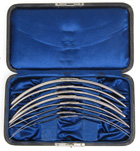
|
9.06 THEOBALD’s PROBES. Unusual set of 19th century American eye doctor’s instruments. This complete set of 8 probes was precisely manufactured of nickel-plated brass. Atop each probe is attached a small double leaf-shaped plaque stamped with two numbers. The numbers indicate the diameter of the probe on each end, ranging in size from the smallest, “1” through the largest, “16.” The set is housed in it original leather-covered hinged wooden case with blue satin lining. A small sliding lock is provided on the front for positive closure. The top of the case is embossed in gold “Set of Theobald’s Probes. The case measures 6 inches long by 3 3/8 inches wide and is 1 inch thick. The exterior leather evidences wear and some minor losses. The interior and contents are perfect. A rare, complete set of early doctor’s tools. 149 In a publication dated 1888, “New Eye Instruments,” J.O. Tansley discusses lachrymal canal or “tear duct” practice at the time, stating that it was “To dilate the canal as much as possible without traumatism.” Samuel Theobald was born in 1846. He began his Baltimore, Maryland medical practice in 1871. Before his appointment at Johns Hopkins, Dr. Theobald was one of the founders of the Baltimore Eye, Ear and Throat Charity Hospital in 1882. In 1889 he founded the Opthamology Department at John’s Hopkins Hospital. In addition to teaching at the medical school and working in the dispensary, he was known for the development of “Theobald lachrymal probes,” the introduction of boric acid as an effective eye wash, and his book, Prevalent Diseases of the Eye. He was a member of the American Ophthalmological Society for 50 years and served as its 14th President. |
CASE |
DETAIL |
PROBE |
Order Info
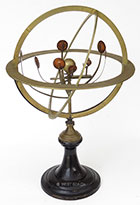
|
9.48 EARLY PLANETARIUM. Important, genuine 18th century solar system model of French manufacture. This very rare second half of the 1700’s Copernican view of a sun-centered solar system is defined by a brass ball in the middle representing the sun. It rests atop a brass rod which supports 8 brass arms mounting revolving planets and a brass gearwork device which rotates the earth and its orbiting moon. Reading outward from the center of the solar system are the planets Mercury, Venus, Earth with its moon, Mars, Ceres, Pallas, Jupiter, Saturn and Uranus. Each is represented with its lithographed identity done on a paper Maché disc. The earth is constructed in the traditional manner with a solid wood core overlaid by stenciled gores. The moon is depicted in ivory. The heavy brass equatorial ring is engraved with 3 scales. The outer scale shows the months of the year divided by 5 day increments. The middle scale indicates the signs of the Zodiac, and the inner scale is calibrated in single degrees by 30 degree arc sectors. The Meridian ring, intersecting the Equatorial ring at the summer and winter solstices, is marked “0” at the Zenith down to 23 degrees where it is marked “SOLSTICE.” Intersecting the Solstice ring at 23 degrees is the elliptic which is marked “EQUINOXES” on both sides of the Meridian The entire presentation is mounted on a cast iron hemispherical frame which supports the equatorial and elliptical rings. It is mounted to a substantial brass cap atop a turned, ebonized wooden base. 19 inches tall by 12 ¼ inches in diameter. The wooden pedestal measures 6 ½ inches in diameter at the base. Truly amazing, beautiful condition. Museum quality! Ceres and Pallas were originally considered planets. But after 1845 and the discovery of asteroid belt, they were reclassified as asteroids. Uranus was discovered in 1781 but was not officially recognized as planet until 1873. |
ABOVE |
DETAIL |
GEARWORK |
ASTEROID STAR |
EQUITORIAL RING |
9.03 ARMILLARY SPHERE. Rare early 19th century model of the solar system made by the famous French globe maker Delamarche as printed on the terrestrial globe in the center. This planetary model is based on the Ptolemaic system devised by early Greek astronomer Claudius Ptolemaeus (A.D. 90 – 128) in which he envisioned the solar system as a set of nested spheres. Ptolemy’s model depicted the Earth at the center of the solar system, whereas the later (and correct) Copernican system was sun-centered. This exceptional example features a pewter equatorial ring engraved in single degrees, 0 – 360. It is supported on a cast iron strut which also houses the brass Meridian ring divided into quadrants of 90 degrees each. As mounted, the Meridian ring is free to revolve and thus indicates the sun’s declination at any time of the year. The broad diagonal paper ring is beautifully engraved with the signs of the Zodiac. The remaining horizontal rings indicate the north and south tropics and the equator. This especially fine model is in a marvelous state of preservation, considering the fact that it is over 200 years old! Museum Quality. ![]()
The first maker to produce globes in France for use by the general public was Charles-Francois Delamarche (1740-1817). Delamarche’s workshop was on Rue du Foin, St. Jacques au College Me. Gervais’, Quartier Latin. Subsequently his addresses were Rue du Jardinet, then No. 7 Rue du Battour, all Paris. Likely this sphere is the work of his son and successor, Felix.
The term Armillary sphere comes from the Latin armilla meaning hoop or bracelet. The earth is shown as a small globe in the center of the sphere which is formed by 2 rings at right angles. The tropics of Cancer and Capricorn (representing the sun’s maximum North and South declinations from the Equator) and the Arctic and Antarctic circles are represented by narrower rings. A broad ring crossing the tropic rings represents the ecliptic or path of the sun. The sphere is mounted within a Meridain ring set into the Equatorial ring. Practical use of the Armillary sphere as a solar system teaching aid was superseded by the Orrery in the early 18th century. (A. Major, Maritime Antiques, 1981, Tantivy Press, London).

|
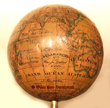
|
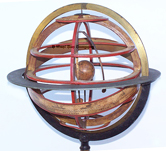
|
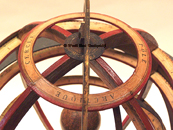
|
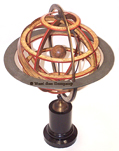
|
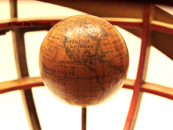
|


